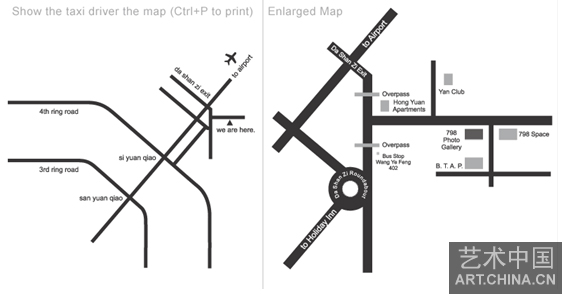| 陳農(nóng)攝影作品展
The Photography of Chen Nong

開幕時間:2007年10月20日15:00
展期:2007年10月20日至11月16日
電話:010-64381784/64375284
電郵: 798@798photogallery.cn
網(wǎng)址:www.798photogallery.cn
地址:北京朝陽區(qū)酒仙橋路4號798工廠內(nèi)大山子藝術(shù)區(qū)百年印象攝影畫廊
Opening time: Oct 20 3:00pm ,2007
Exhibition time: Oct 20,2007 –Nov 16, 2007
Tel: 8610-64381784/64375284
網(wǎng)址:www.798photogallery.cn
Add: No4,Jiu xianqiao road,Chao Yang district, BeiJing.
DIRECTION: 798 PHOTO GALLERY
陳農(nóng)常在他的咖啡館桌上畫畫,桌上放著巨大的照片,一個調(diào)色盤,一支大毛筆,一塊抹布還有一只煙灰缸待在他旁邊。他鋪下一層顏色然后擦干,停下來聊聊天,混合一個新的色彩,在照片的空白處畫下新的形狀,然后再擦擦。幾個小時內(nèi),他飛快順暢的建立著一層層的色彩來不斷完善他的作品。
每一系列的作品都會通過數(shù)月的時間來小心計劃完善。首先是一個想法,一個地方或是主題:兵馬俑,京劇,槍與荷葉,沙地,月球。在拍攝前的幾個星期,陳農(nóng)開始繪制制作紙衣服——用他畫照片的筆和手法——快而輕松的筆觸,同樣的綠色,紅色,藍(lán)色,還有黃色。黑白照片隱匿了所有色彩只留下一些深深淺淺的痕跡。
每一次出行都是一次離開北京的假期, 陳農(nóng)尋找著完美的處所 ,一幫朋友兼做模特或是助手帶著衣服道具什么的。他已經(jīng)在紙上繪制了草圖,到達(dá)現(xiàn)場仍然飛快的設(shè)計新的適合語境的框架;作為一個攝影師——也作為一個畫家——他胸有成竹。在拍攝過程中,很多時間畫在模特的安排和衣服道具的準(zhǔn)備上:一旦畫面確定,他就用極少數(shù)的時間來拍攝。
當(dāng)代中國視覺文化充滿了歷史符號重演——瞬間的輝煌,特定的時期,時代——有精良制作的史詩電影,也有粗制濫造的電視劇用著高價租來的服裝。任何時候你打開電視都能看到無數(shù)的對30年代上海的描繪,全是旗袍和西裝;調(diào)個頻道你又到了60年代,一個有綠衣服和街上沒有汽車的世界;再調(diào)臺你又到了明或是清代:皇宮,或是武俠片。陳農(nóng)的作品回應(yīng)著這樣的視覺環(huán)境,甚至是在他的作品制作方式上——像一個只有一個人的設(shè)計制作部,依據(jù)照片風(fēng)格和他的想像力,做著獨特的道具和服裝。
陳農(nóng)的很多作品把玩著中國歷史圖景——兵馬俑站在月球上,還有一位宇航員(一個未來的出處,可能為將來的旅居月球給出一個中國計劃);人物們穿得像是中國戲劇角色站在傳統(tǒng)的木船上,帶著步槍(紀(jì)念抗日戰(zhàn)爭的稱呼);穿著清代服裝的角色們站在故宮的前面,真的戴大蓋帽穿制服的警衛(wèi)站離一些距離;年輕人穿著同時代服裝戴著動物頭像面具,在古老的灰色胡同玩兒著。雖然很有趣,但陳農(nóng)的照片不僅僅是圖像玩笑,或歷史的雙語。
陳農(nóng)的照片讓人記憶起早期攝影風(fēng)格和人物安排,角色們像是在行為中,但不移動;臉生硬或是沉重;眼睛沒有睜開,盯著相機或是看向遠(yuǎn)方。觀者剛開始注意到的不是歷史感,(例如:京劇服和槍),而是一種沉重的感覺,一種不可追述的情懷。生硬的姿態(tài),混濁的暗影,手工上色,這些元素使陳農(nóng)的照片就如同跟周圍的現(xiàn)實和歷史的記憶若即若離的一個個夢境,也回應(yīng)著我們對現(xiàn)實印象種種說不出來的內(nèi)心感受。像夢一樣,這些圖片有種奇怪的氣質(zhì),這種氣質(zhì)直接與陳農(nóng)的工作方式有關(guān)——通過紙制服裝和照片上色, 介于簡單和奇異風(fēng)格之間。20世紀(jì)早期的肖像攝影用的背景是彩繪的紙而服裝都是真的。陳農(nóng)確是帶著紙衣服來到真的地方。但是當(dāng)照片被洗出來并上色,就很難再將紙衣服從真的環(huán)境中區(qū)分出來。通過畫他的衣服,陳農(nóng)制造出一種幻想和真相,尋找他要的場景,調(diào)整他的模特,拍攝然后制作出照片再上色. Roland Barthes說每一長照片都有一個“出彩”,細(xì)節(jié)吸引著看者。在他看來,出采總是某一個真實的事物——老的鞋子,手的姿態(tài)。但在陳農(nóng)的照片里,亮點不是某個真象,不是屬于那個地方的真的東西,而是扁平的紙衣服和它們被繪制后的樣子,一種短嶄的令人信服的幻像讓人瞬間跌入其中。總之,正是這種繪制服裝和道具的方式(然后再繪制),給了陳農(nóng)的作品這樣的魅力。

Chen Nong paints standing over a table in his coffeeshop, a giant photograph draped over the table, a pallette of inks, a single battered calligraphy brush, a rag and an ashtray perched beside him. He lays a wash of color and wipes it dry, pauses to chat, mixes a new color, draws a shape in the blank spaces of the photograph, and wipes it away. He swiftly, casually builds the layered shades that define his work, finishing a painting in only a few hours.
Each photographic series is carefully planned over the course of several months. It
starts with an idea, a place or an object: clay tomb soldiers; opera costumes, guns and lotus leaves; sand dunes; the moon. For weeks before the shoot, Chen Nong paints paper costumes using the same brush and pallette he uses the paint the photographs—the same quick loose brushstrokes, and the same rich greens, reds, blues and yellows, colors that dissapear in but give depth to the black-and-white prints.
Every shoot is a journey out of Beijing, a group of friends serving as models and assistants carrying costumes and props, as Chen Nong searches for the perfect location.
He has already sketched several frames on paper, but he quickly designs new frames to fit the context. As a photographer—and as a painter—he is decisive. During the shoot, most of the time is spent positioning the models and arranging props and costumes: once the picture has been realized, he takes only a handful of shots.
Contemporary Chinese visual culture is full of historical reenactments—recreations of moments, periods, eras—ranging from highly “realistic” epic films produced with obsessive visual detail, to cheaply shot television dramas with costumes bought off-the-rack in department stores. Any time you turn on the television you see one of countless depictions of Shanghai in the thirties, all natty suits and qipaos; change the channel and you are in the 1960s, a world of padded green suits and streets without cars; change the channel again and you are in the Ming or Qing: a palace drama, or a martial-arts comedy sitcom. Chen Nong’s work echoes this visual environment, and even its mode of production. Like a one-man set-design department, he makes his own props and costumes, relying on reference photographs and his own imagination.
Many of Chen Nong’s photographs play with Chinese historical iconography—tomb soldiers stand on the moon with an astronaut (a reference to the future, perhaps, given China’s plans for moon travel in the next decades); figures dressed like Chinese opera characters stand in a traditional wooden boat, carrying rifles (calling to mind the war of Resistance against the Japanese); characters in Qing costumes sit in front of the Palace Museum, real guards in caps and suits visible in the distance; young people in contemporary street clothes, with giant animal heads, play in old grey hutongs. But though his work is playful, Chen Nong’s photographs are not merely iconographic jokes, or historical puns.
Chen Nong’s pictures bring to mind the staging and expressions of early glass-plate photography. The subjects are posed as if in action, but trying not to move; faces stiff or thoughtful; eyes unfocused, gazing at the camera or into the distance. The first thing the viewer notices is not the historical juxtaposition (i.e., opera costumes and AK47s), but the mood of grave nostalgia. The stiff poses, dark shadows, and painted-on-colors that make Chen Nong’s pictures reminiscent of early photographs also give them the quality of half-remembered dreams, cobbled together from the images that surround and permeate us. Like dreams, these pictures have a strange kind of integrity, an integrity which comes directly from Chen Nong’s process—the link between the easy, gestural style with which he paints the costumes, and applies layers of color to the finished photograph.
Unlike early twentieth century portrait photography, in which the backgrounds were painted paper and the costumes were real, Chen Nong takes paper clothes to real places. But when the photographs are printed and colored, it is hard to distinguish the paper costumes from the real surroundings, to tell what is painted before the photograph, what is painted on the photograph, and what is “really there”. Chen Nong builds layers of illusion and reality by painting his costumes, finding his locations, arranging his models, shooting and printing his photographs and coloring his prints. Roland Barthes describes “the punctum” of the photograph, the tiny detail of the photograph which hooks the viewer. For Barthes, this is always something real, an index of the unique historical moment of the picture—an old shoe, a gesture of the hand. In Chen Nong’s pictures, it is not the real bits which stick out—not the things tied to the real place—but the flatness of the paper costumes, and gestures with which they are painted, the way they fall just short of a convincing illusion. Above all, it is the painterly way the costumes and props are painted (and then repainted), which gives Chen Nong’s works such a haunting beauty.
|

